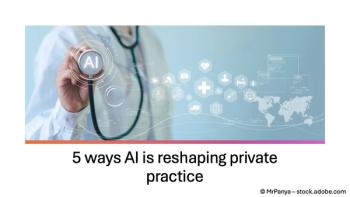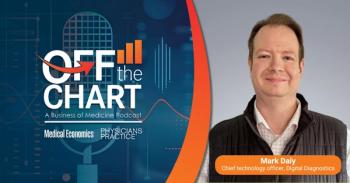
The Tech Doctor: Collaboration Has Its Privileges
Are RHIOs just the latest fad, or is ther some fire behind all the smoke?
We are entering a time in which the latest technologies are creating new communities of care and making connections where none existed before.
A case in point: the EMR, which a growing number of private-practice physicians like you are beginning to adopt.
The EMR is designed for use within your office - to manage the patients who arrive on your doorstep. But as we know, healthcare is a collaboration involving referrals, lab reports from hospitals and imaging centers, and the active exchange of patient information among a variety of caregivers - all of which occur outside your office.
It is these outside-the-office operations that EMRs don’t handle all that well, requiring expensive and often impractical interfaces between disparate computer systems. Interest is thus proliferating (particularly at the public policy level) in an alphabet soup of entities that go under the acronyms RHIO, LHIO, and RHIN.
Regional health information organizations, local health information organizations, and regional health information networks all target the same goal - electronically linking the healthcare communities in which we live and receive care to facilitate the exchange of patient information. For the purpose of this column, I will group these entities under the title “community networks.”
Building a community of care
At the macro level (which is what public policy types really care about), community networks seek to both lower the cost and improve the quality of healthcare delivery. How? Consider this scenario: A patient shows up semiconscious at her local ER, where a smooth-running community network enables the attending physician to quickly access her health history, past and current medications, and previous test and lab results. Timely access to such comprehensive individual patient information in emergency situations would allow physicians to provide optimum care and, at least in some cases, at a lower cost (for example, by avoiding redundant testing).
Other examples of potential benefits made possible by community networks include scenarios your office most likely sees every day. Suppose you examine a patient and determine that he should be seen by a specialist. If you process that referral electronically through a community network, the entire task (including receiving and filing the specialist’s findings) can be handled via a secure Internet connection that can reduce the attendant frustrations of telephone tag, faxing, and snail mail, resulting in considerably less human labor and capital.
The bottom line? The efficient movement of a single patient’s information among all involved caregivers helps every player within our healthcare system.
So how can you access the benefits a community network offers? It’s actually quite simple. First, you choose to become a member of the community network serving your area - much in the same way you choose to use an Internet service provider (ISP). And, as with an ISP, you will very likely pay a monthly subscription fee.
You are then granted access to a secure Web site or portal - one restricted to members of the community network. Once inside the Web site, you possess capabilities that better enable you to communicate with other healthcare providers. You may have secure messaging (allowing you to safely e-mail sensitive patient information to other providers) and the ability to make referrals electronically.
Your capabilities will vary depending upon the software that powers your specific community network. For example, some networks rely on interfacing tools that allow you to both send and receive information directly to and from your EMR; others may maintain personal health records for use by your patients. Still others may incorporate a repository of patient information from all the various healthcare resources within a community.
The benefits of joining these networks can easily add up for you and your staff. Patient data can be accessed, sent, and received nearly effortlessly, since each of these tasks can be accomplished electronically. (Your referral coordinator will love you.)
Where do I start?
Ready to sign up? First you need to determine whether such a network exists in your own community of practice. Community networks are typically sponsored by larger organizations such as hospitals, IPAs, or other entities capable of supplying the IT expertise and capital required to run the network and attract the attention of other providers. Just like fax machines or telephones, such tools hold value only if there are other people with similar tools with whom to communicate.
While very few community networks are currently in operation, many are in the planning stages. Part of the challenge is organizing the network in such a way that it will ensure a neutral administration of data exchange among competitors within the same community. As a result, you will start to see alternative networks being initiated without the organizational overhead required of other, farther-reaching ones. (That’s where RHINs come in.)
What does this mean if you already have an EMR? If a community network is either underway or in the planning stages in your area, ask the folks in charge whether they will offer interfaces among EMRs and the network, and at what price. It’s also worth determining how well your existing EMR will perform with other entities (and again, at what price).
If you don’t yet have an EMR and are considering purchasing one, this is the perfect time to make sure the vendor you are considering offers standards-based interfaces and is seeking or has received EMR certification. (See the June 2006 “Tech Doc” column for more information on this.)
The big picture? Although RHIOs, LHIOs, and RHINs are still young and have a number of technical, organizational, and governmental challenges to surmount, they represent a very positive trend for both physicians and patients.
Bruce Kleaveland is president of Kleaveland Consulting, a management consulting firm focused on healthcare IT. Prior to forming Kleaveland Consulting, he was chief operating officer at a leading EMR company. He can be reached at 206 527 6633,
This article originally appeared in the September 2006 issue of Physicians Practice
Newsletter
Optimize your practice with the Physicians Practice newsletter, offering management pearls, leadership tips, and business strategies tailored for practice administrators and physicians of any specialty.









